|
|
|

|
|
|
|
The Hummingbird
|
|
The sun warrior.
|
|
|
|
Text and photos by Ernesto Francini
|
|
|
|
|
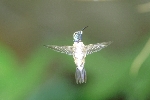
|
|
Purple-collared
woodstar hummingbird (Myrtis fanny) in flight (male).
|
|
|
|
|
For its strong aggressiveness, the rapidity in the flight and
in the stunts, for the stupendous colors of which it is gifted the ancient
American civilization considered it the reincarnation of brave warlike
fallen in battle and the representation in earth of the Sun God.
The Aztecs people adored the god “ blue hummingbird " and
to it they raised their temple.
The Nazca people represented it in the Pampa of Ingenio, in
Peru, in an enormous drawing visible only from the airplane (of which today
the meaning is not known yet).
This small bird, part of Trochilidae family, characteristic of
the American tropical forests, it is today one of the most stupendous
existing animals on our planet.
Nobody, in past, has succeeded to withstand the charm of this
creature.
Cristoforo Colombo described it how "small marvelous bird
very different from ours".The big experts of the zoology, every with a
proper style, tried then to describe it with their words.Audubon compared
it to "fragments of rainbow", Goeldi described it how
"precious stone and flower converted in animal", others simply as
"joy of the nature."
|
|
|
|
|
|
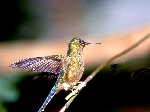
|
|
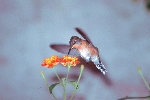
|
|
Long-tailed sylph
hummingbird (Aglaiocercus kingi).
|
|
Purple-collared
woodstar hummingbird (Myrtis fanny) while it’s sucking nectar from a
flower (female).
|
|
|
|
|
|
|
The Hummingbird is the smallest bird of the world.
In nature 334 kinds of Hummingbird exist, that are distribute
in the whole American continent and particularly in South America.
The smallest is the Hummingbird Calypte Helenae which weight
is around 1.6 grams and it is long 5.7 cm (of which 1.25 cm is the only
body length , the rest is tail and bill).It is in competition about size
with the Hummingbird of Vervain (mellisuga minima) of analogous dimensions
nearly.Both are smaller than a lot of kinds of butterflies and moths with
which share the environments of the tropical forest and their nest is great
around as half walnut.
The greatest is the Giant Hummingbird (patagona gigas) which
weight is around 20g and it is long 21.5 cm .
The Hummingbirds are gifted of a plumage with splendid
iridescent colors (that it is found in particular way in the adult males,
while young birds and female generally have more slim colors) and no other
bird can compete with them under this aspect.
Particularity is that the beautiful colors are not due to the
presence of pigments on the feathers, but to the interference of the bright
rays through their prismatic structure, which decomposing the solar light
reflecting only a part of the iris so giving the sensation of metallic
reflexes.
The iridescent plumage allows the Hummingbirds to become
invisible to the predator confusing it with the flower colors. The most
dangerous predators are the snakes which eat their eggs and young birds.
|
|
|
|
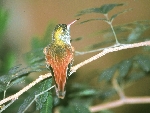
|
|
Amazilia
hummingbird (Amazilia amazilia).
|
|
|
|
|
The pointed bill, straight or slightly bent, it is sometimes
very long and maids to suck up the nectar of the flowers or to eat small
spiders and small bugs that they capture in flight or inside the flower
corollas.
During nectar sucking the bill remains soaked in flowers
pollens, so in this way, with its moving from a flower to the other one,
they also act as natural vehicle for the pollination, which, in nature, it
is possible only with external mobile agents, due to the impossibility of
the vegetables to move itself and carry out the pollens. They Develop
therefore an important role in the maintenance of the ecosystem of the
tropical forests.
A lot of
some beautiful tropical plants entrust their pollination to the
Hummingbird, contrarily they could not exist.In this case the form of the
bill, that is perfectly adapted to the flower, suggests us that there has
been in the time a co-evolution between flower and bird with mutual
advantage: the plant has assured for itself a good pollinater and the
Hummingbird a source of food in exclusive.
|
|
|
|
|
|
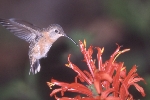
|
|

|
|
Purple-collared
woodstar hummingbird (Myrtis fanny) while it’s sucking nectar from a
flower (female).
|
|
Purple-collared
woodstar hummingbird (Myrtis fanny) in approach to a flower.
|
|
|
|
|
|
|
It flies very quickly thanks to its resistant musculature and
its strong and light feathers and it can reach elevated speed, from 30 to
70 and sometimes also 100 Km/h.
Into tangled vegetation of the forests it is able to move
quickly, but it is also able to fly still in stall position in the air,
near to a flower, while it is sucking nectar of which is nourished;this is
possible tanks to the quickly spiral movement of the wings, that it knows
how to put in action with mastery and that produces static lift rather than
push. It knows how to fly back also or completely turned upside-down, with
the turned back toward the lower part.
These stunts have made possible from the manner according to
which the wings have attached to the shoulders, as they had untied, they
can move itself changing the own angulation. They have sustained then from
of the strong breast muscles, that represent the engine which causes the
push, and whose weight it is equal to 30% of the total weight of the bird.
|
|
|
|

|
|
Typical wing
movements of a hummingbird during the flight, shooting from the bottom.
|
|
|
|
|
The movement of the wings can reach the surprising speed of
70-90 pulsations per second and during courting phases reaches also the 200
pulsations per second (archilochus colubris).No other living bird on the
planet can beat the wings so much quickly.
The movement is so rapid to produce a sonorous humming as that
of a hornet, so in English language they are called " hummingbirds
".This movement, nevertheless, requires a notable waste of energies,
considering the small dimensions of their body, for this the Hummingbirds
need to feed in continuation and are gifted of a rapid metabolism.
To sustain them in efficiency, every day they have to ingest a
quantity of nectar from the flowers, their basic food diet, equal to around
1-4 times their bodily weight.To obtain proteins they integrate their basic
food diet with small spiders and bugs.
In proportion, the dimension of their heart, compared to the
man, it is greater than 5,6 times (archilochus colubris). The cardiac
frequency can reach 1260 pulsations per minute (lampornis clemenciae).
During the night the Hummingbird enters in a state of torpor
or lethargy and voluntarily lowers its own body temperature to 8-10 °C (in
the daytime it is around 40°C) in this way it puts in action a natural
system to save energy and reduces notably its own metabolism.This state
could be also put in action when the bird has few alimentary reserves,it
has been verified that the metabolic rate in this period is about 1/50 of
the alarm state rate.The lethargic sleep can have lasted since 8 to the 14
hours.
|
|
|
|
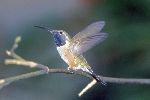
|
|
Purple-collared woodstar hummingbird (Myrtis fanny).
|
|
|
|
|
They belong to the migratory birds people and they complete,
every year, real flight across, in some cases, from one end to the other of
the American continent.
The most northern is the Ruby Throated Hummingbird
(archilochus colubris).It nests in Canada on the Rocky mountains and
winters in Mexico and in Central America and despite its small body
structure (it weighs only 3.5 grams) it completes migration distances more
than 4000 Km.Of these, around 1000 Km are employed to fly over the sea in
the Gulf of Mexico.To complete this travel it stores in its body a layer of
fat equal to half of its really weight.The flight back, in the reproduction
area, is controlled by the spring flowering of the plants in the regions
that it has to cross.
The male normally come back first and it establishes its own
territory before the female return.Males that are taken possession and
defend a specific territory have more possibilities to mate and to attract
female in comparison to non territorial males.
When the female returns they begin the courtship.The male
normally tries of to attract it with the song and continually follows it
with acrobatic flights around it.
It is noticed that this little bird is able to produce an
incredible large differences of vocalizations and, as the human and few
other animals, have developed the rare ability to learn different sounds,
not only those that every kind has innate in oneself from the birth.
Its brain, compared to the little dimensions of the body, it
is one of the greatest within the animal world.
If the produced song is appreciated by the female, the same
one responds and then it begins the mating.After the mating it is the
female that builds the nest. It is normally positioned on the falling
branch of a bush or on a bifurcation of a branch of tree.For the
construction of the nest it generally uses cloth of spider, musk, lichens,
fibers of plants and other material.The nest is minuscule and of shape cup,
when the female has completed it, deposes 1 or 2 small eggs of white
color.It incubates the eggs and breeding the young without the assistance
of the male.The male is normally polygamous and it can have one or more
females contemporarily.
The period of incubation can vary from 13 to 23 days according
of the kind, while the breeding of the young is normally from 18 to 38
days.The young birds are fed with the regurgitation of the mother food,
generally constituted by bugs, since rich of necessary proteins for a rapid
bodily growth.
The Hummingbirds are lonely typically, they live in average
4-5 years and they are associated with the opposite sex for few second only
during the mating.
They are very territorial and defend their food sources and
nest-building area.The male defends the territory, the female the nest.
The control of the territory is effected by the male being
perched on a high branch of tree and holding under observation the
intruders.It emits a warning vocal signal to the foreign approach and, if
such warning is ignored, it throws itself with a flight in dive toward the
" enemy " and it engages a real aerial duel, deed of run after
and stunts where both shows all their cleverness and mastery in the
flight,action made to send away the intruder and to establish supremacy on
the territory.
In some cases this competition can degenerate in a real
struggle including scratches and pushes. At this point the long pointed
beak, of which they are gifted, becomes an arm and more precisely a sword.
|
|
|
|
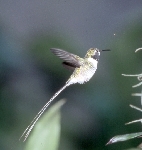
|
|
Peruvian sheartail
hummingbird (Thaumastura cora) while it’s chasing a prey in flight.The prey
is a gnat of fruit (drosophila melanogaster) observable in upper side on
the right.
|
|
|
|
|
In the 19° century hundreds and thousand of Hummingbird had
killed in South America and sent in Europe for decoration.Some people,
fascinated by this attractive colored birdie,wanted it to stuff with straw
to show in its own living room as decoration.Others invented a new fashion
inserting them in the lady hats as ornament.The age news tells of a London
dealer that in one year imported more than 400.000 skins of killed
Hummingbirds.
Luckily this extermination has not continued and this small
bird could have been saved from the extinction.
Fortunately today numerous associations, not for gain money,
exist, which are devoted to protect and study these wonderful birds.The
man, the biggest existing predator on the planet, has perhaps decided to
preserve these small creatures, that our forefathers,probably wiser than
us, adored.Contemporarily he is destroying the Amazonian forest (the only
big lung of oxygen of the planet ) to produce lumber, where the Hummingbird
lives.
Like
naturalist I hope that this splendid birdie becomes the protection symbol
of the American tropical forests and throwing this message to any
intelligent human being that, aware of the importance of the nature for the
continuation of the human life on the earth, wants to pick up it.
|
|
|
|